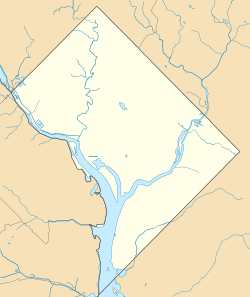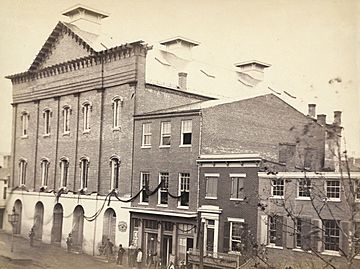Ford's Theatre facts for kids
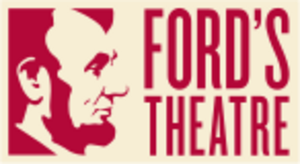 |
|
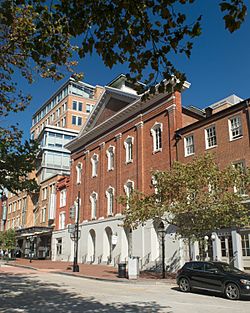 |
|
| Address | 511 10th St, N.W. Washington, D.C. United States |
|---|---|
| Owner | National Park Service |
| Operator | Ford's Theatre Society |
| Type | Regional theater |
| Capacity | 665 |
| Construction | |
| Opened | August 1863 |
| Reopened | 1968, 2009 |
| Website | |
|
Ford's Theatre National Historic Site
|
|
| Area | 0.29 acres (0.12 ha) (theater alone) less than one acre (entire NHS) |
| Built | 1863 |
| Architectural style | Late Victorian |
| Visitation | 856,079 (2005) |
| Website | Ford's Theatre National Historic Site |
| NRHP reference No. | 66000034 |
| Added to NRHP | October 15, 1966 |
Ford's Theatre is a famous theater in Washington, D.C.. It first opened its doors in 1863. This theater is most well-known as the place where Abraham Lincoln, the 16th U.S. President, was shot.
On April 14, 1865, President Lincoln was watching a play called Our American Cousin. An actor named John Wilkes Booth entered Lincoln's theater box. Booth shot President Lincoln in the head. After being shot, Lincoln was taken to the nearby Petersen House. He sadly passed away there the next morning.
After this tragic event, the theater was used as a warehouse and government office. In 1893, part of the building collapsed, causing some deaths. It was later repaired. The building became a museum in 1932. It was then fixed up and reopened as a theater in 1968. A new museum, the Center for Education and Leadership, opened next to Petersen House in 2012.
Today, the Petersen House and the theater are protected as the Ford's Theatre National Historic Site. The National Park Service manages this historic site. The Ford's Theatre Society runs the shows and educational programs.
Contents
History of Ford's Theatre
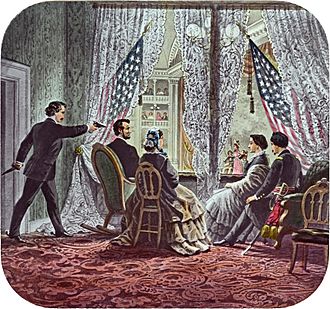
The land where Ford's Theatre stands was once a church. It was built in 1833 for the First Baptist Church. In 1861, a man named John T. Ford bought the old church. He changed it into a theater. He first called it Ford's Athenaeum. A fire destroyed it in 1862, but it was quickly rebuilt.
President Lincoln's Assassination
On April 14, 1865, President Lincoln and his wife went to Ford's Theatre. This was just five days after the Civil War ended. The famous actor John Wilkes Booth was a strong supporter of the Confederacy. He managed to get into the President's special box. Booth then shot Lincoln. After the shooting, Booth jumped onto the stage. He then escaped through a back door. Many people in the theater saw this happen.
After the assassination, the United States government took over the theater. Congress paid John T. Ford $88,000 for it. They also made a rule that the building could never be used for public entertainment again. From 1866 to 1887, the U.S. military used the theater. It held records for the War Department. It also housed the Library of the Surgeon General's Office and the Army Medical Museum. In 1887, it became an office for clerks.
Repairs and Reopening
On June 9, 1893, a part of the building's inside floors collapsed. This happened because a support pillar was weakened during digging in the basement. Twenty-two clerks died, and 68 others were hurt. Some people thought the building was cursed because of this. The building was repaired. The clerks moved back in on July 30, 1894.
In 1928, the War Department handed the building over to another government office. A museum about Lincoln opened on the first floor on February 12, 1932. This was on Lincoln's 123rd birthday. In 1933, the building was given to the National Park Service.
The idea to restore Ford's Theatre took a long time. Two men, Melvin D. Hildreth and Milton Young, worked for two decades to make it happen. They convinced Congress to approve money for a study in 1955. In 1964, Congress approved funds for the actual restoration. The work began that year and finished in 1968.
On January 21, 1968, the restored theater was officially opened. Vice President Hubert Humphrey and 500 guests attended. The theater reopened for performances on January 30, 1968. The presidential box where Lincoln was shot is never used.
The theater was updated again in the 2000s. It can now seat 665 people. The reopening ceremony was on February 11, 2009. This day marked Lincoln's 200th birthday. President Barack Obama spoke at the event. Many famous people also appeared.
Ford's Theatre National Historic Site
The Ford's Theatre National Historic Site includes two important buildings. These are the theater itself and the Petersen House. It was given this special status in 1932.
The Ford's Theatre Museum is located beneath the theater. It holds many items from the Olroyd Collection of Lincolniana. The museum was last updated in July 2009. It is run by the National Park Service and the Ford's Theatre Society.
The museum has many items related to the assassination. These include:
- The Derringer pistol used in the shooting.
- Booth's diary.
- The original door to Lincoln's theater box.
You can also see some of Lincoln's family items. His coat (without the blood-stained parts) is there. There are also statues and large pictures of the President. The blood-stained pillow from Lincoln's deathbed is also in the museum. The museum teaches about the assassination. It also covers Lincoln's life in Washington, his family, and his role as a leader. It has exhibits about the Civil War and the theater's history. The rocking chair Lincoln sat in is now at The Henry Ford Museum in Dearborn, Michigan.
Petersen House: Where Lincoln Died

After Lincoln was shot, doctors had soldiers carry him outside. They were looking for a house where he could be more comfortable. A man on the steps of tailor William Petersen's house called to them. They carried Lincoln into a first-floor bedroom. They laid him on the bed. He was so tall they had to lay him diagonally. Many people visited him that night. He died the next morning at 7:22 a.m.
The U.S. government bought the Petersen House in 1896. It was called the "House Where Lincoln Died." This was the first time the government bought a historic home. The National Park Service has run it as a historic house museum since 1933. The rooms are set up just as they were on the night Lincoln died.
See also
 In Spanish: Teatro Ford para niños
In Spanish: Teatro Ford para niños
- Abraham Lincoln Birthplace National Historic Site
- Abraham Lincoln Presidential Library and Museum
- Lincoln Boyhood National Memorial
- Lincoln Home National Historic Site
- Lincoln Memorial
- Lincoln Memorial University
- Lincoln Tomb
- Mount Rushmore
- National Register of Historic Places listings in central Washington, D.C.
- Theater in Washington, D.C.
- President Lincoln's Cottage
- Presidential memorials in the United States



